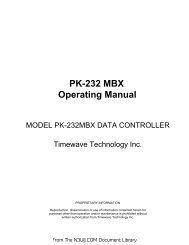You also want an ePaper? Increase the reach of your titles
YUMPU automatically turns print PDFs into web optimized ePapers that Google loves.
4-1-6 10 MHz IF CIRCUIT (MAIN UNIT)The 10 MHz IF signal from the mixer circuit is passedthrough a monolithic filter (Fl51 [Main], Fl651 [Sub]) to suppressout-of-band signals. The filtered signal is amplified atthe IF amplifier (Q51 [Main], Q651 [Sub]). The IF amplifierprovides 20 dB gain.The amplified signal is then applied to the different circuitsdepending on the selected mode.(1) FM modeThe signal is applied to an FM IF <strong>IC</strong> pin 16 (<strong>IC</strong>401 [Main] or<strong>IC</strong>951 [Sub]).(2) SSB and CW modeThe signal is passed through a 10 MHz IF filter (FI151/10.85MHz [Main] or Fl751/10.95 MHz [Sub]) or optional CW narrowfilters. The filtered signal is amplified at the IF amplifiers(Q350–Q352 [Main] or Q850–Q852 [Sub]) and then appliedto a demodulator circuit.4-1-7 DEMODULATOR CIRCUIT (MAIN UNIT)(1) FM modeThe 10 MHz IF signal from an IF amplifier (Q51 [Main] orQ651 [Sub]) is applied to the mixer section of the FM IF <strong>IC</strong>(<strong>IC</strong>401 [Main], <strong>IC</strong>951 [Sub], pin 16), and is mixed with a LOsignal (10.395 MHz [Main], 10.495 MHz [Sub]) to produce a455 kHz IF signal. The LO signal is generated by the BFOcircuit (PLL unit; <strong>IC</strong>601 [Main], <strong>IC</strong>701 [Sub]).The FM detector circuit employs the quadrature detectionmethod, which uses a ceramic discriminator (X401 [Main],X951 [Sub]) for phase delay to obtain a non-adjusting circuit.The detected signals are output from pin 9, and applied tothe squelch control and center indication detector circuits,etc.(2) SSB and CW modesThe amplified signal from the IF amplifier circuit (Q51 [Main],Q651 [Sub]) is applied to the balanced mixer circuit (<strong>IC</strong>351[Main], <strong>IC</strong>851 [Sub]) to demodulate into AF signals.Demodulated audio signals are output from pin 1, andapplied to the squelch control gate (<strong>IC</strong>452 [Main], <strong>IC</strong>1002[Sub]).BFO circuit (PLL unit; <strong>IC</strong>601 [Main] and <strong>IC</strong>701 [Sub]) generatesBFO signals for using in the balanced mixers.• BFO frequenciesMode for MAIN band for SUB bandUSBLSBCW10.8485 MHz10.8515 MHz10.8483 MHz10.9485 MHz10.9515 MHz10.9483 MHz4-1-8 SQUELCH CONTROL CIRCUIT (MAIN UNIT)The demodulated AF signals from the balanced mixer circuitor FM IF <strong>IC</strong> are applied to the squelch control gate (<strong>IC</strong>452[Main], <strong>IC</strong>1002 [Sub]). This consists of 4 analog switcheswhich are selected with a mode signal and squelch controlsignal from the CPU (DISPLAY board; <strong>IC</strong>1) via the expander<strong>IC</strong> (<strong>IC</strong>1491). The switched AF signals are applied to the AFcircuit.4-1-9 SQUELCH CIRCUIT (MAIN UNIT)(1) FM modeA squelch circuit cuts out AF signals when no RF signal isreceived or the S-meter signal is lower than the [SQL] controlsetting level. By detecting noise components in the AFsignals, the CPU switches the squelch control gate.A portion of the AF signals from the FM IF <strong>IC</strong> pin 9 (<strong>IC</strong>401[Main], <strong>IC</strong>951 [Sub]) passes through the active filter sectionof FM IF<strong>IC</strong> (pin 8). The active filter section amplifies and filtersnoise components. The filtered signals are applied tothe noise detector section for conversion into DC voltageand output from pin 14 (<strong>IC</strong>401 [Main], <strong>IC</strong>951 [Sub]) as the“NSQM [Main]/NSQS [Sub]” signal. The “NSQM [Main]/NSQS [Sub]” signal is applied to the DISPLAY board.The DC voltages are passed through the analog multiplexer(DISPLAY board; <strong>IC</strong>5, pins 15 and 2) and then applied to theCPU (DISPLAY board; <strong>IC</strong>1, pins 93, 94) via the MP1Y andMP1X signal lines. The [SQL] level signal is also applied tothe CPU via the analog multiplexer (DISPLAY board; <strong>IC</strong>3,pins 14, 5) as a reference voltage for comparison with thenoise signals. Also, an S-meter signal is applied to the CPUfrom FM IF <strong>IC</strong> pin 12 (<strong>IC</strong>401 [Main], <strong>IC</strong>951 [Sub]) via themeter amplifier (<strong>IC</strong>1804c [Main], <strong>IC</strong>1804a [Sub]) and analogmultiplexer (DISPLAY board; <strong>IC</strong>4, pins 12 and 1). The CPUcompares these signals, then outputs a control signals tothe squelch control gate.(2) SSB and CW modesThe squelch circuit mutes audio output when the S-metersignal is lower than the [SQL] control setting level.A portion of the 10 MHz IF signal from the IF amplifier (Q352[Main], Q852 [Sub]) is converted into DC voltage at the AGCdetector (D303, Q305 [Main], D902 Q901 [Sub]) and amplifiedat the meter amplifier (<strong>IC</strong>1804d [Main] or <strong>IC</strong>1804b[Sub]). The amplified signal is passed through the analogmultiplexer (DISPLAY board; <strong>IC</strong>4, pins 12 and 1) via theSMLM [Main]/ SMLS [Sub] signals and then applied to theCPU (DISPLAY board; <strong>IC</strong>1). The CPU outputs control signalsto the squelch control gate when the S-meter signal islow level.4-1-10 AF AMPLIFIER CIRCUIT (MAIN UNIT)The AF amplifier circuit amplifiers the demodulated signalsto drive a speaker. For the separate speaker function, astereo power amplifier is used.AF signals from the squelch control gate are passed throughthe AF filter (<strong>IC</strong>451a [Main], <strong>IC</strong>1001a [Sub]) and AF preamplifier(<strong>IC</strong>451b [Main], <strong>IC</strong>1001b [Sub]) and then amplifiedat the voltage controlled amplifier (VCA: <strong>IC</strong>1808 [Main],<strong>IC</strong>1809 [Sub]) which functions as a volume control using the[AF] control signal. The amplified AF signals are applied tothe AF power amplifier circuit (<strong>IC</strong>1852, pin 2 [Main], pin 5[Sub]).The amplified audio signals of SUB band are output from pin7, and are applied to the external speaker jack for the SUBband (J1852) via the [PHONE] jack (JACK board; J1). Whenno plug is connected to the jack, the signals are fed back tothe MAIN band audio. The mixed audio is applied to theinternal speaker via the [PHONE] jack and external speakerjack for the MAIN band (J1851).4 - 2From The <strong>N3UJJ</strong>.COM Document Library
















